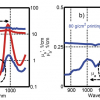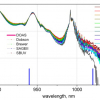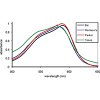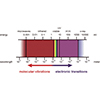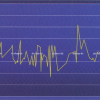Articles
In the Tony Davies Column, we learn about “Automated detection of counterfeit drugs using multimodal spectroscopy and advanced web-based software platforms”. With the increase in trafficking of counterfeit medicines and other products, there is a need for definitive results from an on-site analyser useable by customs officers. The German authorities have commissioned the development of a multi-modal, transportable inspection system, including intelligent data processing and evaluation, for fast spectroscopic recognition of illicit drugs and counterfeit medicines. This is described in the column.
The analysis of turbid samples is increasingly important, not least due to their widespread occurrence in natural samples. Dmitry Khoptyar, Sören Johansson, Staffan Strömblad and Stefan Andersson-Engels show “Broadband photon time-of-flight spectroscopy as a prospective tool in biomedicine and industrial process and quality control”. The authors describe their recent development of a broadband spectrometer for evaluation of absorption and scattering spectra of very diverse turbid materials in the visible and close-near infrared (NIR) regions and its application with milk, cheese and paper samples.
With the threat of climate change, understanding the workings of our atmosphere is of crucial importance. Ozone is the most important trace gas in the stratosphere and troposphere and it is monitored by both satellite-borne and ground-based instruments. Accurate knowledge of ozone absorption cross-sections is vital for this work and described in this article.
BBCEAS is a new cavity-based absorption technique that uses broadband sources rather than lasers. This offers potential improvements in signal-to-noise but often lower spectral resolution compared to techniques where the laser wavelength is scanned. The article concentrates on liquid-phase applications, an interesting new area since most cavity-based absorption studies have been performed on gas-phase species up to now.
The intense development of industrial and urban areas in the absence of accurate measures to control pollution sources is often the cause of several environmental problems: dispersed and undetected chemical waste problems, in particular trace elements such as heavy metals, may cause freshwater, soil and water-table contamination. Such events are rarely detectable by sporadic analyses on water samples, since trace element concentrations are often below the instrumental detection limits and/or quickly change in space and time.
This short review shows that UV/visible spectroscopy plays a key role in the discrimination of colour in the forensic analysis of fibres and inks. The application of chemometrics, however, is vital in many cases to enhance such discrimination and to put it on a quantitative basis so providing objective justification for the conclusions of the analyst.
Christopher Burgess
Burgess Analytical Consultancy Limited, “Rose Rae”, The Lendings, Startforth, Barnard Castle, Co. Durham, DL 12 9AB, UK
John Hammond
Starna Scientific Ltd, 52–54 Fowler Road, Hainault Business Park, Hainault, Essex, IG6 3UT, UK/p>
As the column title rightly suggests Quality does Matter. The authors look at the major changes that have taken place over the last 50 years in four key areas: The National Metrology Institutes (NMIs), the instrument manufacturers, the user base and the globalisation of regulation through international regulatory bodies.
Thin polymer layers on solid substrates are of high technological importance due to their increasing potential for applications in electronics, sensors, nanotechnology and biotechnology. Appropriate characterisation methods are necessary for the design and analysis of devices made using such materials. This review article focuses upon presenting the many analytical possibilities for quantitative evaluation of the optical constants and thickness of polymer layers by combined application of spectroscopic ellipsometry (SE) in the visible (vis) and infrared (IR) spectral range.
UV/vis reflection spectroscopy is a practical method to investigate pulp ageing, especially when reflectance spectra are converted to absorbance (k/s) spectra. Even if detailed reaction paths cannot be solved with this technique alone, it provides a very fast and simple method to study the changes in the concentrations of certain important pulp components during ageing. In addition, the concentrations of these components have been studied also in other pulp processes, such as mechanical and chemical pulp bleaching.
G. Langergraber,a J. van den Broeke,b,* W. Lettlb and A. Weingartnerb
aInstitute for Sanitary Engineering and Water Pollution Control, BOKU - University of Natural Resources and Applied Life Sciences, Vienna, Muthgasse 18, A-1190 Vienna, Austria. E-mail: [email protected]
bs::can Messtechnik GmbH, Brigittagasse 22-24, A-1200 Vienna, Austria. E-mail: [email protected]
As the first compact on-line instruments for use in the field have been on the market for several years, this article reviews their capabilities and applications.
John P. Hammond
Analytical Products, Optiglass Ltd, Hainult, Essex, UK. E-mail: [email protected]
This article highlights four areas of research where the use of tunable synchrotron radiation radiation in the vacuum-UV has led to important discoveries. These studies have exploited the tunability of such sources, albeit at moderate resolution.
Gabriel Pinto and Isabel Paz
Departamento de Ingeniería Química Industrial y del Medio Ambiente, E.T.S.I. Industriales, Universidad Politécnica de Madrid, José Gutiérrez Abascal 2, 28006 Madrid, Spain
Luis Oliveira and Manuel Pais Clemente
CETO – Centro de Ciências e Tecnologias Ópticas, Rua Caldas Xavier, Nº38, 6º E, 4150 Porto, Portugal. E-mail: [email protected]
This article discusses the development of new Certified Reference Materials (CRMs) for use in determining the essential accuracy and linearity of the Transmission scale of a conventional UV/vis spectrophotometer.

